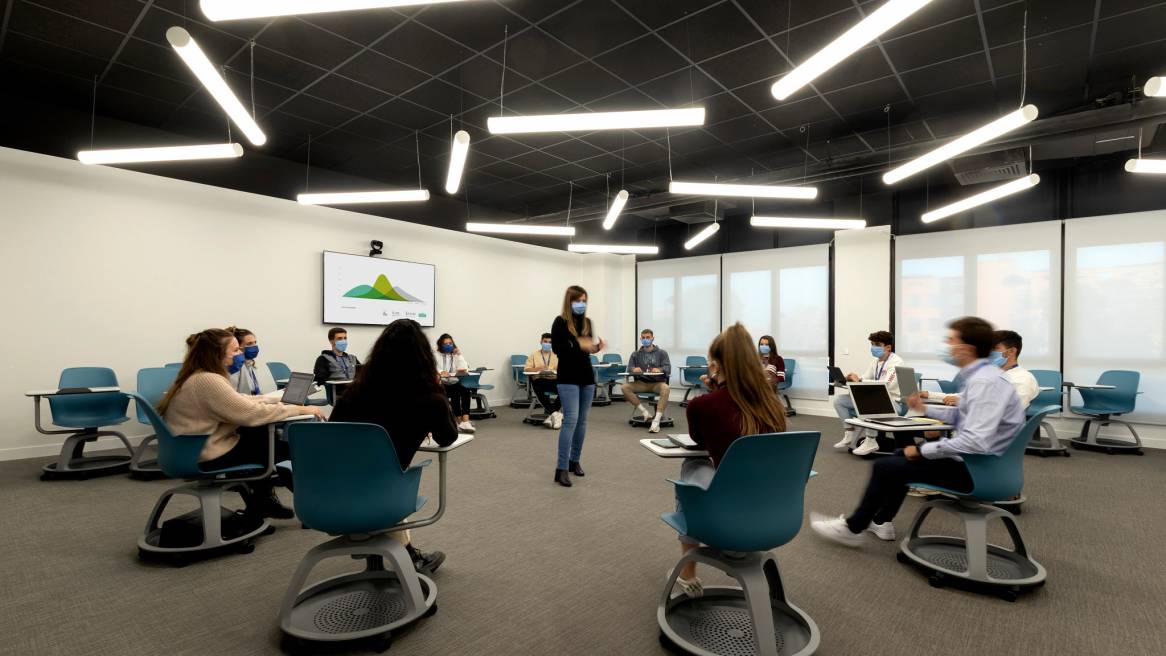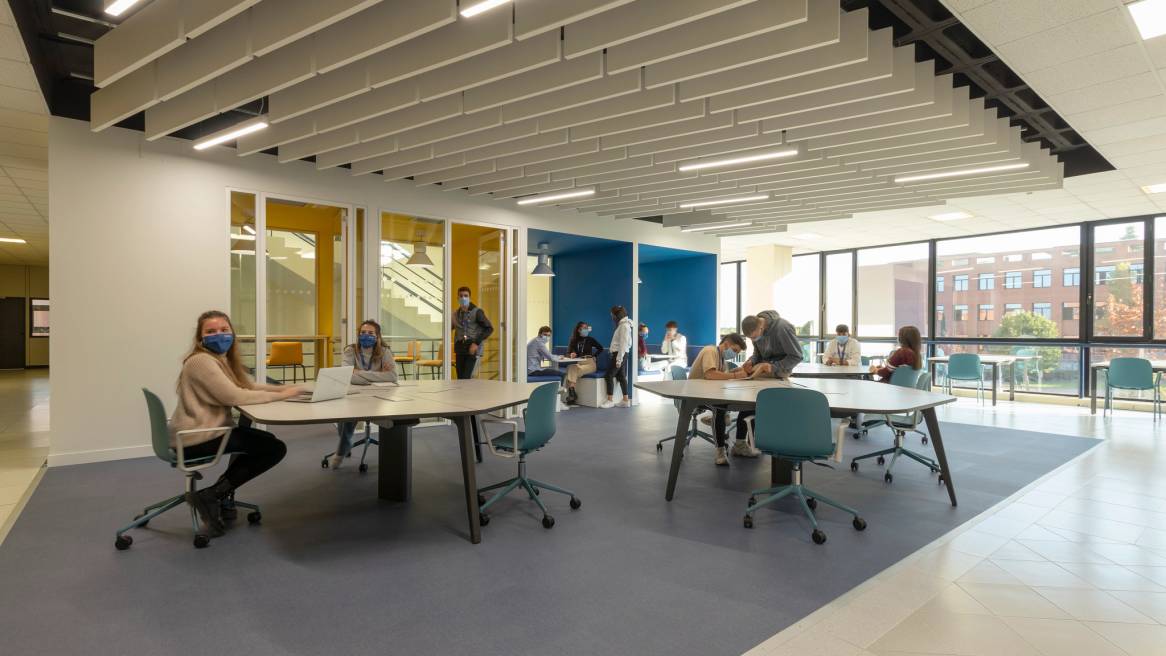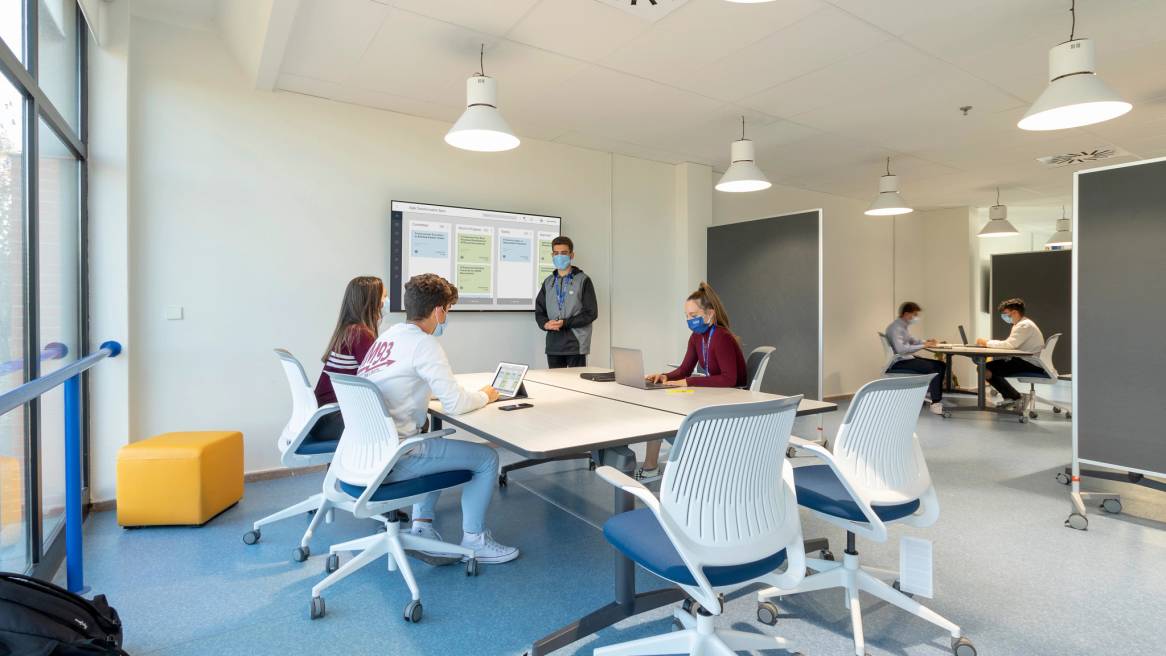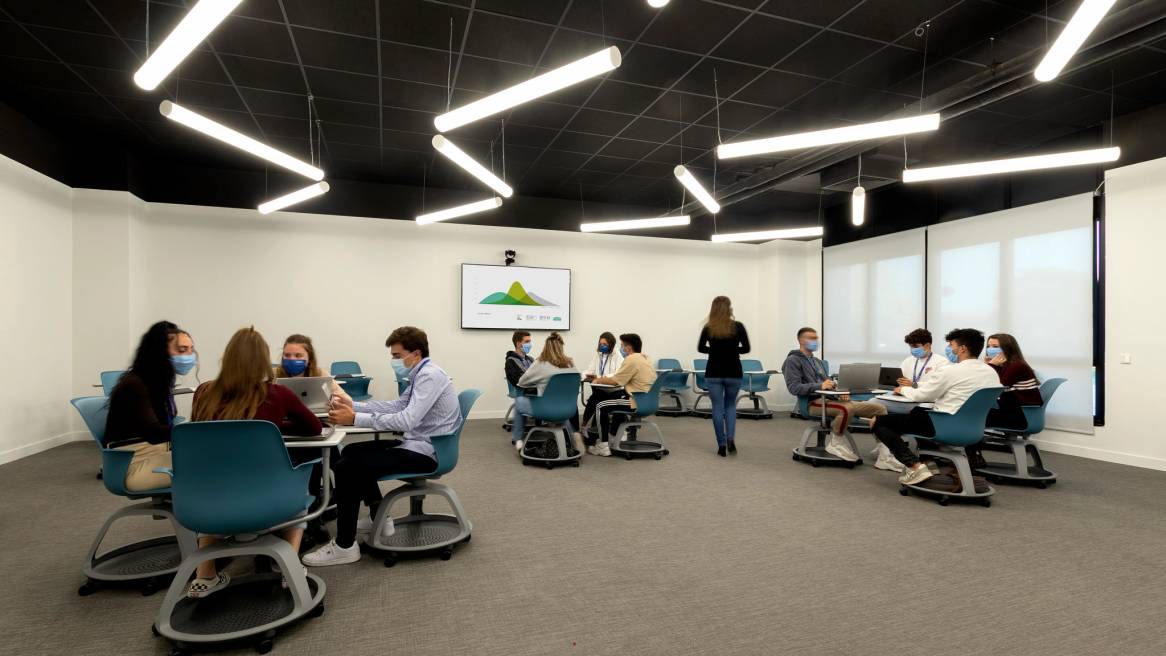New spaces of the Alfonso X el Sabio University
The Alfonso X el Sabio University has transformed its educational spaces to adapt them to current and future teaching needs, going for areas that are modern, flexible and innovative, and that above all offer students a quality education.
1. THE STARTING POINT
Active learning is characterised by flexibility and the different teaching models, and is the guiding principle within our new educational ecosystem, which means that its design must take teaching method, technology and space into account. The goal is to make this active learning rigorous and of high quality in all university spaces.
When it comes to designing educational spaces, we must also consider the evolving role of the teaching staff and their teaching models. A lot of the information that teachers have from the students can now be found on the Internet. As a result, many of these professionals are taking advantage of technology to transform their classroom role. In this way, they can use their time with the students to provide greater educational value, for example by progress in problem-solving, taking an interest in their concerns and supporting communication and collaboration.
There is no doubt that technology is transforming education, and thus the concept of its spaces. Now, as well as being more innovative and flexible, these have to support multiple models of teaching and learning; democratising the ability to see, hear and be comfortable. Technology must allow the space to adjust to the necessity of use; it must be capable of enabling continual support and advice; it must be able to share analogue and digital information; and it must offer access to different tools and present the information dynamically.
For a long time, many universities and schools have felt a clear need to incorporate these trends. In the wake of an unprecedented educational transformation, schools and institutions are obliged to be nimbler than ever in finding innovative solutions that will allow them to compete in this new scenario.
2. the university
Organisations across the globe are coming to terms with this transformation, and we are proud to say that the Alfonso X el Sabio University is among them.
This Madrid University is aware of the importance of an active learning space in helping to boost students’ creativity and participation, and has taken a major step towards an innovative project.
As a benchmark educational centre, it is concerned not only with offering good content in its degree courses, but also applying a teaching methodology where space plays a fundamental role, becoming the vehicle for enhancing teaching and making learning easier for its students.
3. the goals
The old ways of doing things are yielding to a deeper, wider and more individualised perspective of what success means for students and how to achieve it.
In both Steelcase and UAX, we know that for students in today’s world success goes far beyond acquiring and demonstrating knowledge. Practical skills and personal development are also necessary for reaching educational goals, but so are the personal ones that will serve the students throughout their lives.
For all these reasons, the goal of the transformation of spaces at UAX was to strengthen student involvement and make them the true motors of learning. As part of a high-impact strategy for students to succeed, it is important to evaluate the campus as a connected system of innovative spaces of active learning that work together to help the students achieve success. We know that the surroundings can greatly increase students’ level of commitment and also of wellbeing.
Following the philosophy of its motto “Bonum est diffusivum sui” (Goodness always tends to spread), the University set itself the following strategic goals:
- Investing in talent and knowledge
- Inspiration in our points of reference
- Conquering the future
- Innovation
- Internationalisation
- Generating relationship networks
- Commitment and accompaniment
Once these goals had been defined it was important to identify the strategic goals of the space, being 100% aligned with what the university wanted to achieve.
- Helping the future professionals to face the challenges of the new world
- Generating connection
- Critical thought
- Fostering community
- Transparency
- Giving possibilities and tools
“With the “traditional” classroom model we were not able to implement new teaching methodologies. Now, we can give hybrid classes of the highest quality, with half of the students present and the other half online”.
JAVIER PÉREZ DE DIEGOVice-Rector for Operations at UAX
4. STARTING THE PROJECT
The Villanueva de la Cañada Campus of the Alfonso X el Sabio University covers 1,000,000 m2 and is designed for over 15,000 students to study for their degrees with innovative methodologies, just 25 kilometres from Madrid.
Currently, the campus has 140 classrooms in four buildings. In this transformation, Steelcase took charge of five different spaces including Open UAX, hybrid classrooms, collaboration zones and a work room inside the library.
HYBRID CLASSROOMS
For active learning to be possible, the classrooms must be flexible so that they can adapt easily to new teaching methodologies. The students must be able to create, to hack the space according to their needs, to perform projects, to collaborate, and so on without the space being a barrier for them.
After a specialised strategic design, with the aim of adapting the space to the new needs of teachers and students, while also bearing in mind the COVID scenario, we designed hybrid classrooms ready for the in-person and virtual classes.
Now, it is important to have spaces to train the skills of communication, critical thought and reflection. The need for videoconferences has increased and spaces are required with the necessary acoustics and lighting.
For this reason we have been working on the acoustics, the lighting and the building automation; paying special attention to innovation and new technologies as a fundamental lever for educational development. We have incorporated screens that offer both physically present and remote students an interactive panel that shows the content that is being taught, with cameras and microphones.
As for equipment, the space now has different mobile solutions that support active learning and can be reconfigured quickly. All of this is intended to encourage collaboration among students.

OPEN UAX AND COLLABORATION ZONE
Creativity and critical thought are two of the skills for which there is the greatest demand in the world of work.
Open UAX and the Collaboration Zone are environments designed to help the students solve problems, develop solutions, share ideas, and in other ways increase their practical and social skills.
These zones comprise an open space and various classrooms fitted with sofas, phone booths and concentration cabins, so that they can be used for study or any task that needs a high level of attention. In this way, open spaces are combined to promote learning and collaboration, without overlooking the periods of concentrated work that every team needs to continue contributing ideas.

LIBRARY
Informal interactions with teachers and fellow students allow students to widen their outlooks, mature emotionally and develop valuable relationships that often exert a positive influence throughout their lives when they have finished studying. Regardless of whether it is used for gaining orientation, delving more deeply into a subject or simply relating with other people to give one’s mind a rest, having easy access to other people helps the students to develop.
So, the library has been designed with the intention of helping in the creative process. It offers places to think, spaces to create and experiment and spaces for sharing, because it doesn’t matter how good an idea is; if others are not convinced, the idea will die.

5. AND WHAT ARE THE RESULTS?
Designing active learning spaces means providing a variety of places to support multiple models of teaching and allowing them to adapt easily. Currently, the Alfonso X el Sabio University has premises that have been renovated and are so innovative that they are positioned as an element that is absolutely different from the rest.
Now, its spaces have more synchronisation of devices with software, allowing the collaboration of multiple users and supporting virtual conversations, both inside and outside the classroom. The result is a space that allows more personalised learning while offering easier and more efficient access to education.
“Without doubt the greatest achievement has been a change of mentality in the teaching staff because they have been able to implement a more attractive and effective methodology.”
JAVIER PÉREZ DE DIEGOVice-Rector for Operations at UAX
There is no doubt that technology applied to teaching space provides value both for the University and for the students and teachers, prioritising the development of their cognitive, physical and emotional wellbeing. As things are now, it is essential to have hybrid classrooms, flexible, modular spaces, and, of course, with the value of innovation and connectivity – a proposal for success that will achieve quality education adapted to every moment, that this university now has.
Thanks to this transformation, the Alfonso X el Sabio University can provide spaces that not only help to promote students’ motivation and commitment, but that also help with the social and personal skills that are so necessary in their personal development.


